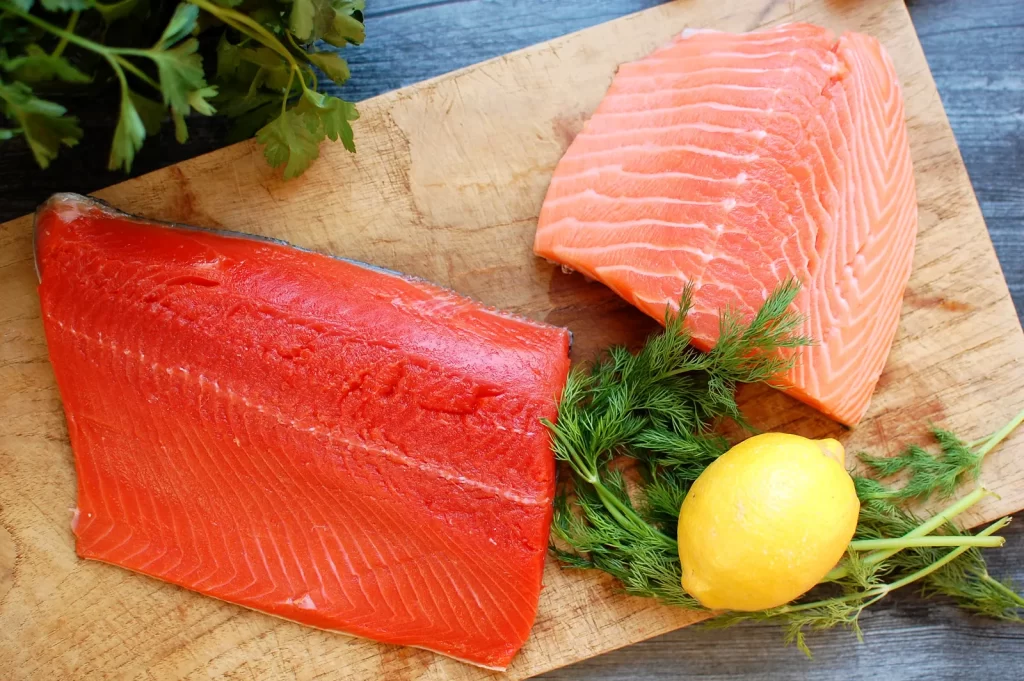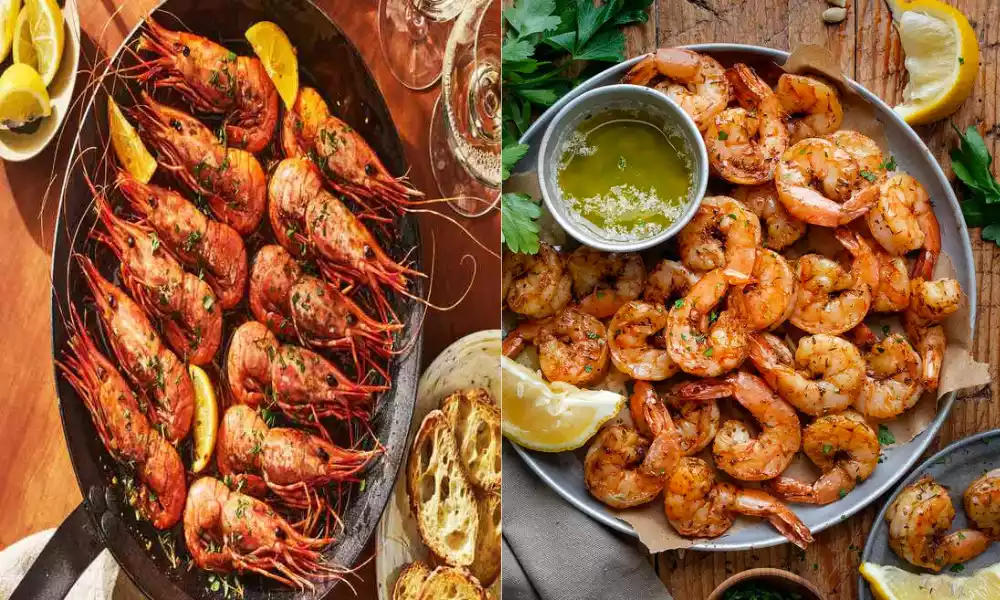Sashimi and sushi are both traditional Japanese dishes that are popular worldwide, yet they have distinct differences. Sashimi refers to thinly sliced raw fish or seafood, served without rice. It is often enjoyed for its fresh, natural flavors and is typically accompanied by soy sauce and wasabi. In contrast, sushi is a dish that includes vinegared rice combined with various ingredients such as seafood, vegetables, and occasionally tropical fruits.
Sushi comes in various forms, including nigiri (hand-pressed sushi), maki (rolled sushi), and temaki (hand-rolled cones of sushi). While sushi can include raw fish, it also often features cooked or marinated ingredients. Both sashimi and sushi are central to Japanese cuisine and are appreciated for their delicate flavors and artistic presentation.
Origin and History
The origins and history of sashimi and sushi are deeply rooted in Japanese culture and cuisine, each with its unique development over time.
Sashimi
- Early Origins: The concept of eating raw fish is ancient and can be traced back to Japan’s Jomon period (14,000–300 BC). However, the specific practice of preparing and consuming raw fish as sashimi began later.
- Historical Development: Sashimi, as it is known today, started to take shape in the Muromachi period (1336–1573) when the technique of filleting fish was refined.
- Etimology: The term “sashimi” comes from the culinary practice of sticking the fish’s tail and fin to the slices in order to identify the fish being eaten.
- Cultural Significance: Sashimi became a key element in Japanese haute cuisine, especially with the rise of the samurai class, who appreciated its simplicity and elegance.
Sushi
- Early Origins: Sushi has its origins in an ancient Southeast Asian practice known as narezushi, where fish was fermented with salt and rice, possibly starting as far back as the 2nd century BC. This method was initially used as a means to preserve fish.
- Introduction to Japan: This preservation technique arrived in Japan in the Yayoi period (300 BC – 300 AD). Over time, this evolved into a form of cuisine rather than just a preservation method.
- Evolution: By the Edo period (1603–1868), sushi began to resemble its modern form. Vinegar was added to the rice, and the fermentation process was reduced or eliminated, creating a fresher and more flavorful dish.
- Nigiri Sushi: The invention of nigiri sushi (hand-formed sushi) by Hanaya Yohei in the early 19th century in Edo (modern-day Tokyo) marked a significant turning point. This style became popularized and is one of the most recognizable forms of sushi today.
- Global Popularity: In the 20th century, especially after World War II, sushi spread globally and evolved into various forms, incorporating local ingredients and tastes.
Sashimi and sushi reflect the Japanese appreciation for the natural flavors of ingredients and have evolved through a combination of culinary innovation and tradition. Their rich history is a testament to Japan’s gastronomic heritage and its influence on global cuisine.
What is Sashimi?
Sashimi is a traditional Japanese delicacy consisting of finely sliced raw fish or seafood. Unlike sushi, sashimi is served without rice, allowing the natural flavors and textures of the fish to take center stage.
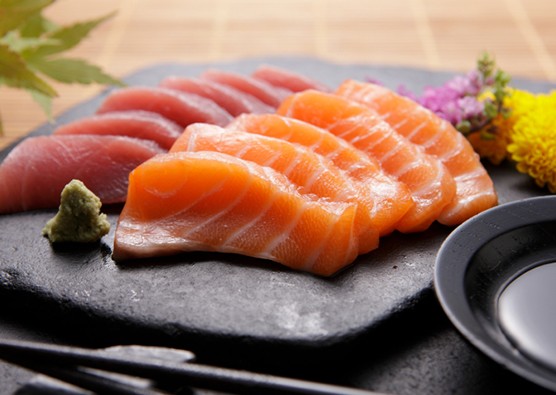
Typically, it includes a variety of fish such as tuna, salmon, and mackerel, but can also feature other seafood like octopus or shrimp. Sashimi is often appreciated for its freshness and quality, with an emphasis on skillful preparation and presentation. It is commonly accompanied by condiments like soy sauce, wasabi, and pickled ginger, which complement and enhance the flavors of the raw fish. The simplicity and elegance of sashimi make it a beloved and integral part of Japanese cuisine.
What is Sushi?
Sushi is a renowned Japanese dish known for its unique combination of vinegared rice and various other ingredients, including seafood, vegetables, and occasionally tropical fruits. The term “sushi” actually refers to the specially prepared rice, seasoned with vinegar, sugar, and salt. This rice is then paired with different toppings or fillings. Sushi comes in several forms, such as nigiri (hand-pressed sushi with a slice of fish or seafood on top), maki (sushi rolls wrapped in seaweed), and temaki (hand-rolled sushi cones).
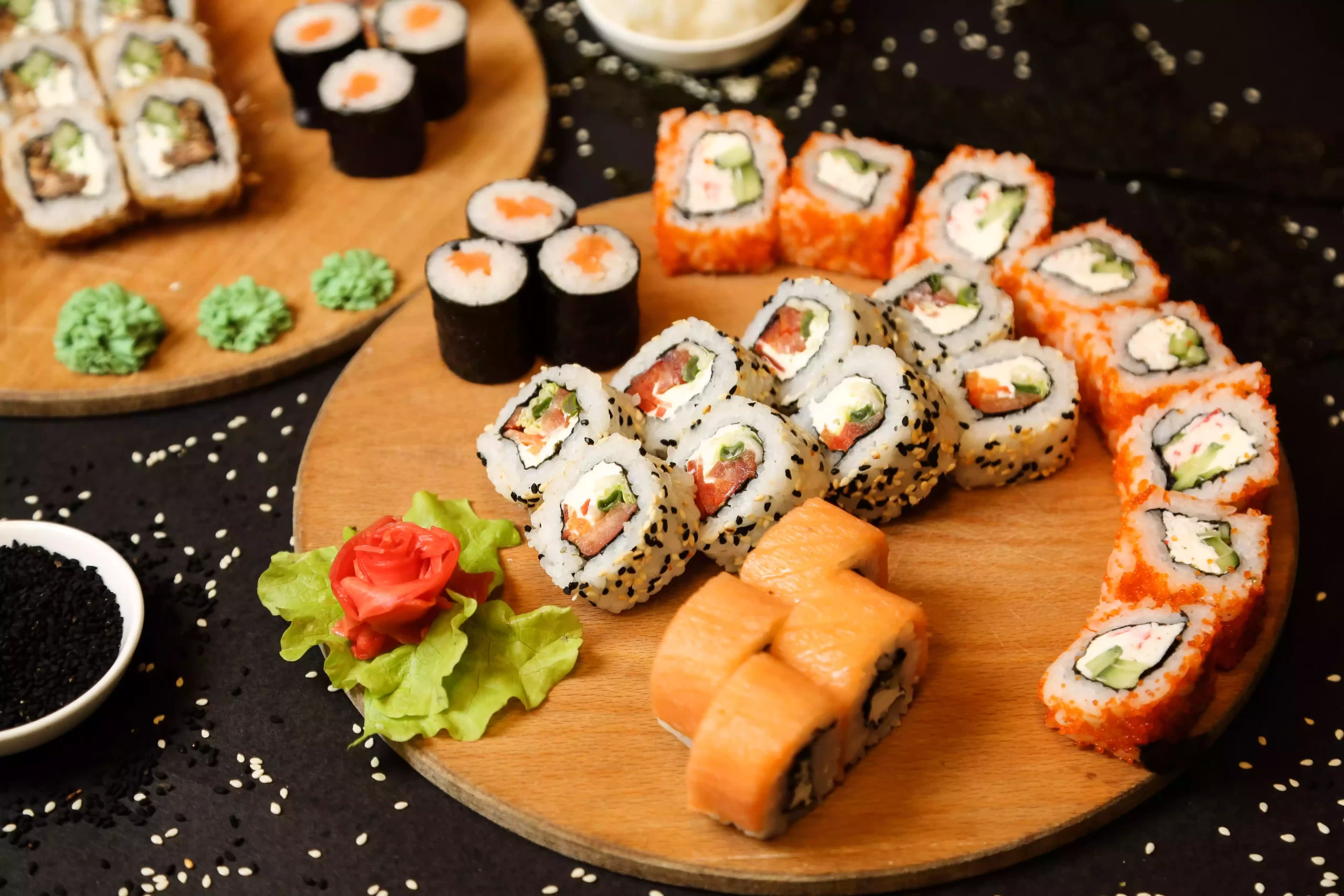
While sushi often includes raw fish, it can also feature cooked or marinated ingredients, making it a versatile and widely appreciated dish. The art of sushi-making emphasizes balance and presentation, with chefs skillfully combining flavors and textures for both aesthetic appeal and taste. Sushi’s popularity extends far beyond Japan, making it a globally recognized and enjoyed cuisine.
Importance of knowing their differences
Understanding the differences between sashimi and sushi is important for several reasons:
- Cultural Appreciation: Knowing the distinction between these two Japanese culinary traditions demonstrates respect and appreciation for the culture. It shows an understanding of the nuances and traditions in Japanese cuisine, which is often characterized by its attention to detail and presentation.
- Dietary Considerations: For individuals with specific dietary preferences or restrictions, distinguishing between sashimi and sushi is crucial. For instance, those who want to avoid carbohydrates or are on a keto diet might prefer sashimi, as it doesn’t contain rice. Conversely, individuals allergic to certain seafood or who prefer vegetarian options might opt for specific types of sushi.
- Culinary Experience: Distinguishing between the two can enhance the dining experience. Sushi and sashimi offer different textures, flavors, and ways of enjoying Japanese cuisine. Understanding this helps in making informed choices that align with personal tastes and interests.
- Nutritional Aspects: Sashimi, being primarily raw fish, is rich in proteins and omega-3 fatty acids, with lower calorie count due to the absence of rice. Sushi, on the other hand, includes rice and sometimes additional ingredients like avocado or mayonnaise, which changes its nutritional profile. Knowledge of these differences can be important for those mindful of their dietary intake.
- Food Preparation and Safety: Recognizing what each dish represents aids in understanding their preparation methods. Sashimi requires extremely fresh, high-quality fish due to its raw nature, which is crucial for food safety. Sushi, while also often containing raw fish, includes other ingredients and preparation styles, which may affect its storage and consumption guidelines.
Knowing the differences between sashimi and sushi enriches the dining experience, demonstrates cultural sensitivity, aids in adhering to dietary needs, and ensures a better understanding of the nutritional and safety aspects of these dishes.
Comparison table of Sashimi vs Sushi
Here’s a comparison table outlining the key differences between Sashimi and Sushi:
| Feature | Sashimi | Sushi |
| Definition | Thinly sliced raw fish or seafood. | A dish made with vinegared rice combined with various ingredients like seafood, vegetables, and sometimes tropical fruits. |
| Rice | Does not include rice. | Always includes specially prepared vinegared rice. |
| Preparation | Focuses on the freshness and quality of the raw fish or seafood, often served with soy sauce and wasabi. | Involves skillful combination of rice with various ingredients; includes styles like nigiri, maki, and temaki. |
| Ingredients | Primarily raw fish or seafood. | Can include raw or cooked fish, seafood, vegetables, and other ingredients. |
| Serving Style | Typically served as slices on a platter, sometimes over shredded daikon radish. | Served in various forms, such as rolls or individual pieces. |
| Flavor Profile | Emphasizes the natural flavors and textures of the seafood. | Offers a variety of flavors and textures, combining the taste of rice, fish, and other components. |
| Cultural Significance | Appreciated for its simplicity and the skill in slicing and presenting the fish. | Celebrated for its artistic presentation and the balance of flavors. |
This table highlights the primary differences in ingredients, preparation, and presentation of Sashimi and Sushi, both integral parts of Japanese cuisine.
What Are The Most Common Sushi And Sashimi Available?
Sushi and sashimi come in a variety of types, featuring different kinds of fish and seafood.
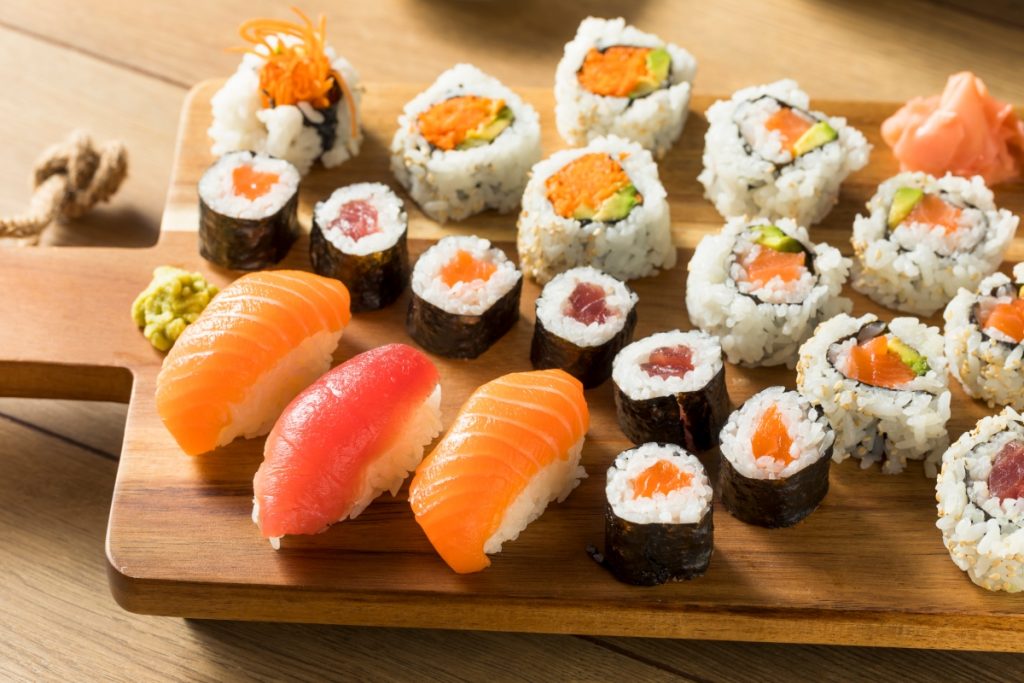
Here are some of the most common and popular kinds:
Common Types of Sushi
- Nigiri: A slice of raw fish over pressed vinegared rice. Popular choices include:
- Salmon (Sake)
- Tuna (Maguro)
- Eel (Unagi)
- Shrimp (Ebi)
- Octopus (Tako)
- Maki: Rolled sushi in seaweed, containing rice and various fillings. Common types include:
- California Roll: Crab meat (or imitation), avocado, cucumber.
- Spicy Tuna Roll: Tuna with spicy mayo.
- Vegetable Roll: Various vegetables like cucumber, avocado, bell pepper.
- Philadelphia Roll: Salmon, cream cheese, and cucumber.
- Temaki: Hand-rolled sushi cones filled with rice, fish, and vegetables.
- Uramaki: Inside-out rolls where rice is on the outside. The California Roll is a famous example.
- Sashimi Roll: A type of maki roll where sashimi is the main ingredient, often without rice.
Common Types of Sashimi
- Salmon (Sake): Known for its smooth texture and rich flavor.
- Tuna: There are different types, such as:
- Bluefin Tuna (Maguro)
- Yellowfin Tuna (Ahi)
- Bigeye Tuna
- Yellowtail (Hamachi): Valued for its buttery taste and firm texture.
- Mackerel (Saba): Often served marinated or cured.
- Octopus (Tako): Known for its chewier texture.
- Sea Urchin (Uni): A delicacy with a creamy, rich flavor.
- Squid (Ika): Slightly sweet with a firm texture.
Which is More Safe To Eat?
When considering the safety of eating sashimi versus sushi, several factors come into play, and it’s important to understand that both can be safe if prepared and handled correctly. There are specific considerations for each:
Sashimi
- Raw Fish Concerns: Sashimi is thinly sliced raw fish or seafood. The primary safety concern with raw fish is the potential presence of parasites and bacteria. To mitigate this risk, it is essential to use fresh, high-quality, sashimi-grade fish that has been properly handled and frozen to kill parasites.
- Freshness: The freshness of the fish is crucial. It should be consumed as soon as possible after being prepared to minimize the risk of bacterial growth.
Sushi
- Variety of Ingredients: Sushi often includes a mix of raw and cooked ingredients, which can include vegetables, cooked seafood, and sometimes tropical fruits. The inclusion of cooked ingredients can sometimes make sushi a safer option compared to sashimi.
- Rice and Vinegar: The vinegared rice used in sushi can be slightly acidic, which can help inhibit bacterial growth. However, this does not eliminate all risks associated with raw fish.
General Safety Tips
- Quality of Ingredients: Always use high-quality, fresh, sashimi-grade fish whether you’re eating sashimi or sushi.
- Proper Handling and Storage: Ensure that the fish has been stored at the right temperature and handled with good hygiene practices.
- Trustworthy Sources: Eat sushi and sashimi from reputable restaurants or sources known for their high standards in quality and safety.
- Be Aware of Allergies: If you have allergies, especially to seafood, be cautious and well-informed about the ingredients.
- Pregnant and Immunocompromised Individuals: Those who are pregnant, immunocompromised, or have certain health conditions should consult with a healthcare provider before consuming raw fish.
How to Make Sashimi
Making sashimi involves a simple yet precise process, focusing on the quality and freshness of the fish or seafood and the skill of slicing it. Here’s a basic guide on how to make sashimi:
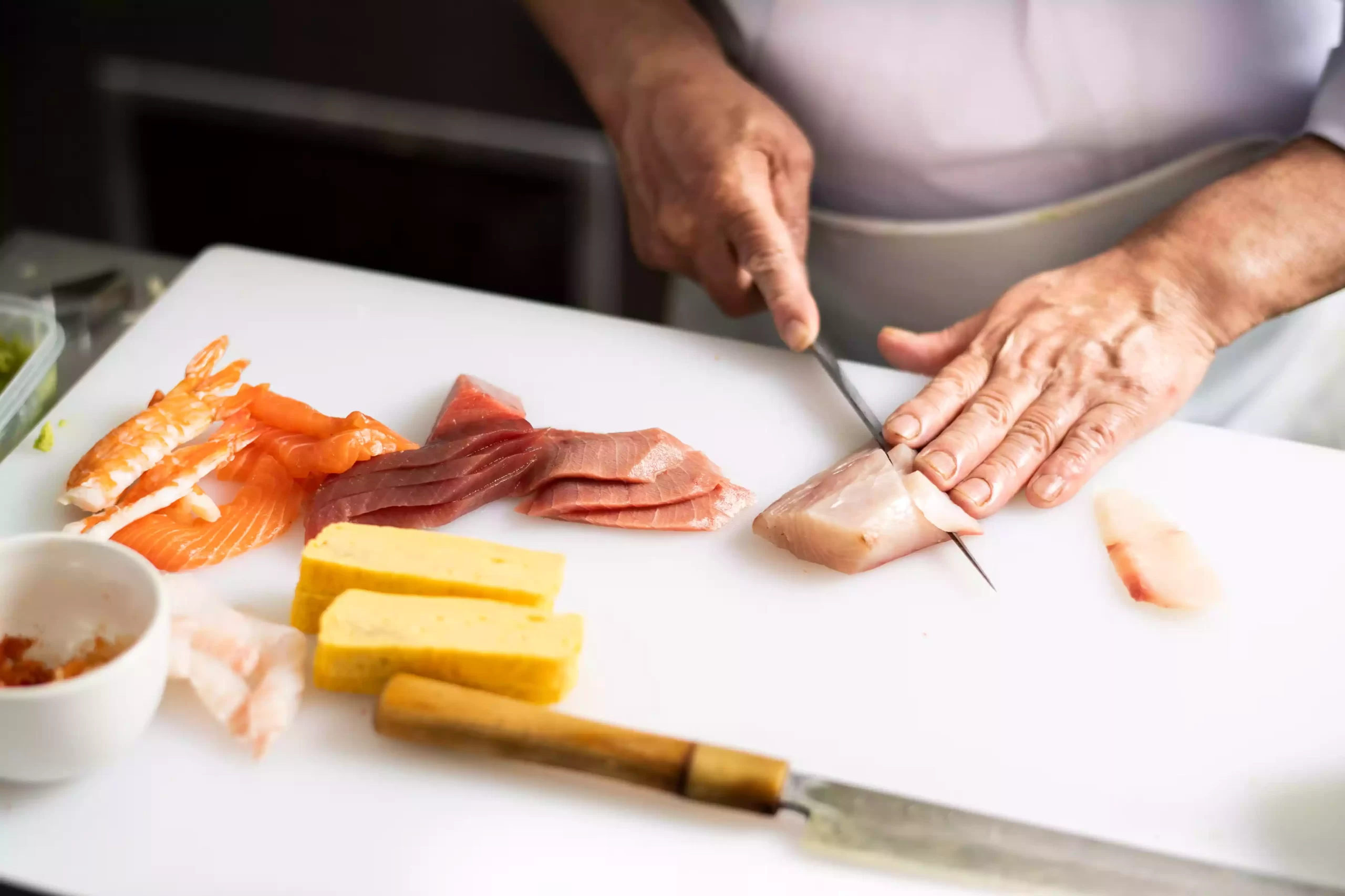
Ingredients
- Fresh, high-quality sashimi-grade fish (like tuna, salmon, mackerel)
- Soy sauce (for dipping)
- Wasabi (optional)
- Pickled ginger (optional)
- Daikon radish (for garnish, optional)
Equipment
- A very sharp knife (preferably a sashimi knife like Yanagiba)
- A cutting board
- Serving plates
Instructions
- Selecting the Fish: Ensure the fish is of the highest quality and freshness. Sashimi-grade fish is specifically intended for raw consumption and is usually available at specialty markets or fishmongers.
- Preparation of the Fish:
- If the fish is not already cleaned and filleted, do so with great care.
- Remove any bones and skin, if necessary.
- Slicing the Fish:
- Chill the fish slightly to make it firmer, which aids in precise slicing.
- Hold the knife at an angle and slice the fish against the grain. The thickness of the slices varies depending on the type of fish but is typically around 1/4 inch (about 5 mm).
- Use a single, smooth motion to make each cut, aiming for clean, even slices.
- Plating:
- Arrange the slices neatly on a plate. You can garnish with shredded daikon radish for a traditional presentation.
- Serve with small dishes of soy sauce, and if desired, a small amount of wasabi and pickled ginger on the side.
- Eating Sashimi:
- It is typically eaten by dipping a slice lightly in soy sauce. Wasabi can be mixed into the soy sauce or placed on the fish, according to personal preference.
Important Tips
- Safety First: Always use fresh, sashimi-grade fish to avoid the risk of foodborne illness.
- Knife Skills: The quality of the cut affects the texture and taste. A very sharp knife is essential for smooth, clean slices.
- Serving Temperature: Sashimi should be served soon after it’s prepared to enjoy its freshness. It’s best consumed at slightly below room temperature.
Making sashimi is as much an art as it is a culinary practice, and it’s celebrated for the way it highlights the natural flavors and textures of the seafood.
How to Make Sushi

Making sushi is a delightful culinary art that combines skill and creativity. Here’s a basic guide to making sushi at home:
Ingredients
- Sushi rice (short-grain rice)
- Rice vinegar
- Sugar
- Salt
- Nori sheets (seaweed sheets)
- Fresh sashimi-grade fish (like salmon, tuna)
- Vegetables (like cucumber, avocado)
- Soy sauce (for dipping)
- Wasabi and pickled ginger (for serving)
Equipment
- Bamboo sushi mat
- Sharp knife
- Rice cooker or pot
- Mixing bowl
- Wet cloth
Instructions
Preparing Sushi Rice
- Rinse and Cook the Rice: Rinse the sushi rice under cold water until the water runs clear. Cook the rice according to package instructions or in a rice cooker.
- Season the Rice: Mix rice vinegar, sugar, and salt in a small pan and heat until sugar dissolves. Cool the mixture. Once the rice is cooked and slightly cooled, gently fold in the vinegar mixture without crushing the grains.
- Cool the Rice: Spread the rice on a tray and let it cool to room temperature.
Making Sushi Rolls (Maki)
- Prepare Ingredients: Slice fish and vegetables into long, thin strips.
- Nori Sheet: Place a nori sheet on a bamboo mat.
- Spread the Rice: With wet fingers, evenly spread a thin layer of rice over the nori, leaving about an inch uncovered at the top.
- Add Fillings: Lay strips of fish and vegetables on the rice towards the bottom of the nori.
- Roll the Sushi: Lift the edge of the mat over the ingredients, tucking the nori to start a roll. Continue rolling, using the mat to firmly shape the sushi into a cylinder.
- Slice the Roll: With a wet, sharp knife, slice the roll into bite-sized pieces.
Making Nigiri Sushi
- Shape the Rice: Wet your hands to prevent sticking and take a small amount of rice, shaping it into a small oblong form with gentle pressure.
- Prepare the Fish: Cut the fish into thin slices.
- Assemble: Place a slice of fish on top of the rice. Optionally, you can put a small dab of wasabi between the rice and fish.
Serving
- Serve sushi with small dishes of soy sauce for dipping, and wasabi and pickled ginger on the side.
Tips
- Fish Quality: Always use fresh, sashimi-grade fish for safety and quality.
- Rice Consistency: The rice should be sticky but not mushy. Getting the rice right is crucial for good sushi.
- Practice: Making sushi is an art that takes practice, especially rolling and slicing.
- Creativity: Feel free to experiment with different fillings and types of sushi.
Making sushi at home can be a fun and rewarding experience. It’s a versatile dish that allows for a lot of creativity, so don’t hesitate to try different combinations and styles!
Which one is healthier?
Sushi and sashimi can be considered healthy options, but there are some differences to consider:

Sashimi
- Lower in Calories and Carbohydrates: Since sashimi is simply raw fish without rice or additional ingredients, it is generally lower in calories and carbohydrates.
- Rich in Omega-3 Fatty Acids: Like sushi, sashimi is an excellent source of omega-3 fatty acids, particularly if it’s made with fatty fish like salmon or mackerel.
- Protein-Rich: Sashimi provides a good source of lean protein.
Sushi
- Varied Nutritional Profile: Sushi can vary widely in its nutritional content depending on the ingredients used. Rolls with vegetables and lean fish can be very healthy.
- Higher in Calories and Carbohydrates: Due to the rice and additional ingredients like mayonnaise or cream cheese in some rolls, sushi can be higher in calories and carbohydrates.
- Includes Vegetables: Some sushi varieties include vegetables, adding vitamins, minerals, and fiber.
Considerations
- Sauce and Condiments: The healthiness can be influenced by what you add to your sushi or sashimi, like soy sauce (high in sodium) or mayonnaise-based sauces (high in calories and fat).
- Portion Control: As with any food, moderation is key.
Both sushi and sashimi can be part of a healthy diet. Sashimi might be a slightly healthier option due to its lower calorie and carbohydrate content, but the healthiness of sushi greatly depends on the specific ingredients used in each roll.
Conclusion
Sashimi and sushi aren’t only culinary delights, but also iconic cultural symbols with deep histories and a rich tradition. This article took you into the realm of both Japanese dishes that highlight their distinctiveness and international attraction.

